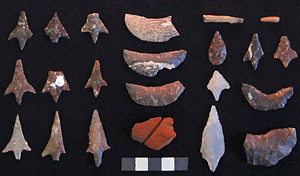

(Courtesy University of Oregon)
Stone tools found at three sites in California's Channel Islands show that a group of people adapted to coastal living had moved into North America by about 12,200 years ago. Archaeologists previously thought that the continent was inhabited only by the big-game-hunting Clovis culture at that time.
A team of archaeologists led by Jon Erlandson of the University of Oregon and Torben Rick of the Smithsonian Institution uncovered stemmed as well as crescent-shaped projectile points that are similar to tools found throughout the Great Basin (an area that covers parts of Oregon, Nevada, Utah, and California). In both places they were used to hunt birds and aquatic life as well as some medium- and small-sized game.
Erlandson believes the discovery shows that the settlement of the Americas was more complicated than the old view that big-game hunters came through an inland ice-free corridor and then spread gradually to the sea. "It suggests that people may have migrated down the coast, and taken left turns inland up the major river valleys," he says. "It would have been a relatively easy transition from the coast to the interior lakes."
Advertisement

Advertisement







